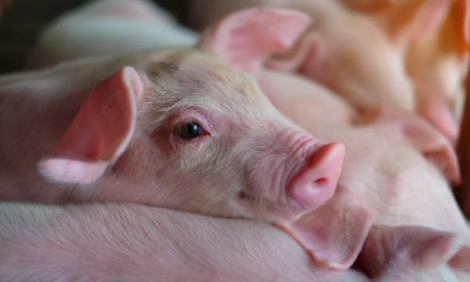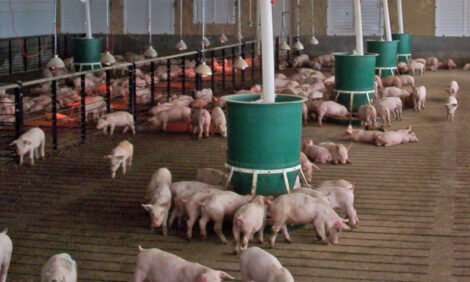



Lysine for Early Weaned Pigs
By Eduardo Beltranena, John F. Patience, Alison Orr and Claire Jardine - The rapid changes occurring in the management of the weaned pig, concurrent with rapidly increasing expectations of animal performance, suggest that diet formulations acceptable in the past may no longer suffice. The current experiment focused on the lysine requirement of pigs from 28 to 56 days of age.
Summary
A total of 240 pigs were randomly allotted from within weight groups to pens and one of six dietary treatments, representing total lysine:DE ratios of 2.7, 3.0, 3.3, 3.6, 3.9 and 4.2 g/Mcal.
A significant linear but not quadratic response to dietary lysine was observed for both rate and efficiency of weight gain. The lack of a quadratic response indicated that the level of lysine at which animal performance would be maximized, must be either at or above the highest lysine level evaluated.
We conclude that the lysine requirement for maximum performance in the rapidly growing early-weaned pig may be above currently accepted levels and require further review.
Introduction
The changing nature of piglet management, combined with higher expectations of animal performance, emphasizes the need to carefully scrutinize existing feeding and management programs to ensure they are, in fact, optimal. From a nutritional perspective, the possible alteration in immune function, combined with increased lean growth rate, suggests that nutrient requirements defined previously, under different management systems, may no longer apply. In addition, under commercial conditions, a wide range in nursery pig performance is observed, again suggesting a need to revisit amino acid requirements.
The lysine requirement of the weanling pig has evolved considerably over the past two decades. For example, the NRC 1988 recommended 1.15% total lysine (3.3 g/Mcal DE) for piglets over 5 kg and 0.95% (2.7 g/Mcal DE) for piglets over 10 kg bodyweight. More recent estimates are generally higher, but surprisingly consistent. For example, the 1994 Kansas Swine Nutrition Guide recommended 1.25% total lysine for pigs weighing more than 7.5 kg. Texas A&M University also recommended total dietary lysine levels of 1.25%, equivalent to 3.6 g lysine/Mcal DE, for pigs of the same body weight. Our 1995 Swine Nutrition Guide recommended 3.2 g lysine/Mcal DE.
A complete review of the amino acid requirements of the early-weaned piglet must clearly start with lysine, the first limiting amino acid in most practical diets. From this basis, information on other amino acids can be defined, leading ultimately to the development of optimum feeding programs, i.e. those which maximize producer net income while taking into account a differing array of economic, environmental and genetic circumstances. The objective of this experiment was to define the response of the early weaned piglet to varying lysine:energy ratios in the Phase III nursery diet.
Experimental Procedure
Two hundred and forty pigs, weaned at 14 days of age were housed in three on-site nursery rooms which were managed in an all-in all-out basis. Although no sex effect was expected, males and females were housed in separate pens. Animals were randomly allotted from within weight groups to pens.
At the time of weaning, all pigs were offered an “SEW Diet” for a period of five days, followed by a “Transition Diet” for the next eight days. Pens of same sex pigs were then randomly allocated to receive one of the six treatment diets starting on Day 13 postweaning when they were 28 days of age and remained on test until they were 56 days of age. Pigs had free access to water from nipple drinkers and the diets from pen self-feeders.
A total of six dietary treatments, representing total lysine:DE ratios of 2.7, 3.0, 3.3, 3.6, 3.9 and 4.2 g total lysine/Mcal were formulated (Table 1). Diets contained 3.5 Mcal DE/kg and were based on wheat, lactose, fishmeal, wheat gluten meal and soybean meal. The elevated lysine levels were achieved by adding lysine as lysine hydrochloride. Other crystalline amino acids were supplemented as required to maintain appropriate levels relative to lysine, according to the principles of ideal protein.
The diets were submitted for amino acid assay confirming that actual lysine levels were consistent with calculated values (Table 2). The assays also confirmed that appropriate ratios of other amino acids to lysine were maintained as well. The diet containing the second highest level of lysine assayed low in methionine and threonine. Because no crystalline methionine was added to this diet, and the mix sheets confirmed the appropriate addition of threonine, we suspect an error in sampling or analysis is the most likely explanation for this discrepancy.
Pigs were weighed on the day of weaning (Day 0), on Day 5 when the pigs were changed to the Transition diet, on Day 13, when the pigs were started on the test diets, and every seven days thereafter.
Results and Discussion
Average age (14.4 ± 0.2 days) and weaning weight (5.00 ± 0.12 kg) were constant across treatments (Table 3). All pens received common diets for the first thirteen days after weaning, so their weights were not different across treatments before the start of the test period.
There was a significant linear response (P < 0.05) but not a significant quadratic response (P > 0.05) to lysine in terms of body weight and average daily weight gain (Table 3). This applied to each week of the experimental period and overall. Weekly body weights and weight gain were analyzed using both individual pig and average pen data. Statistical analysis of both data sets revealed that the same interpretation would have been drawn in both cases (Tables 3 and 4).
There was no effect of lysine level on average daily feed (Table 4), except during the final week of the experimental period (P < 0.05). With no effect of lysine on feed intake, but a significant effect on average daily gain, it was therefore not surprising to observe that feed efficiency responded linearly to dietary lysine concentration (P < 0.05).
It is clear from these data that pigs growing at a rapid rate, with an excellent appetite, require more lysine than is currently recommended in order to maximize rate and efficiency of weight gain. Because only the linear effect was significant, and the quadratic effect was not, we can conclude that the highest level of lysine supplementation was inadequate to maximize performance. It is also interesting to note that increasing lysine resulted in increased growth rate during each week of the experiment, i.e. until the pigs were 56 days of age.
Conclusions
We conclude that the current standards applied by the industry with respect to dietary lysine levels are not adequate to maximize the performance of the early-weaned pigs. Currently, it is unusual for commercial nursery diets offered during this period to contain more than 1.3% total lysine. The fact that a linear response was observed to 1.47% indicates that diet formulation should be reconsidered. Further studies are required to characterize the true lysine requirement. The level of lysine which maximizes growth rate and feed efficiency, was unfortunately not defined in the present trial.
Further studies are also needed in the area of dietary energy response; this is the subject of other study at the Prairie Swine Centre.
Acknowledgments
The authors acknowledge with gratitude the financial support of the Saskatchewan Agriculture Development Fund and the Alberta Agriculture Research Institute.
Source - Prairie Swine Centre - November 2003








